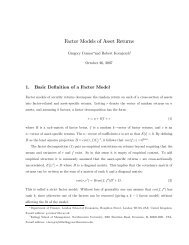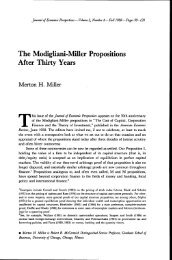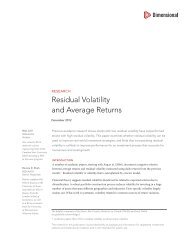Campbell, John Y, Jens Hilscher and Jan Szilagyi, 2005.
Campbell, John Y, Jens Hilscher and Jan Szilagyi, 2005.
Campbell, John Y, Jens Hilscher and Jan Szilagyi, 2005.
You also want an ePaper? Increase the reach of your titles
YUMPU automatically turns print PDFs into web optimized ePapers that Google loves.
explanatory power to the reduced-form variables already included in our model. 3Third, we examine what happens to our specification as we increase the horizonat which we are trying to predict failure. Consistent with our expectations, wefind that our most persistent forecasting variable, market capitalization, becomesrelatively more important as we predict further into the future. Volatility <strong>and</strong> themarket-book ratio also become more important at long horizons relative to net income,leverage, <strong>and</strong> recent equity returns.Fourth, we study time-variation in the number of failures. We compare therealized frequency of failure to the predicted frequency over time. Although themodel underpredicts the frequency of failure in the 1980s <strong>and</strong> overpredicts it in the1990s, the model fits the general time pattern quite well.Finally, we use our fitted probability of failure as a measure of financial distress<strong>and</strong> calculate the risks <strong>and</strong> average returns on portfolios of stocks sorted by this fittedprobability. We find that financially distressed firms have high market betas <strong>and</strong> highloadings on the HML <strong>and</strong> SMB factors proposed by Fama <strong>and</strong> French (1993, 1996) tocapture the value <strong>and</strong> size effects. However they do not have high average returns,suggesting that the equity market has not properly priced distress risk.Thereisalargerelatedliteraturethatstudiesthepredictionofcorporatebankruptcy.The literature varies in choice of variables to predict bankruptcy <strong>and</strong> themethodology used to estimate the likelihood of bankruptcy. Altman (1968), Ohlson(1980), <strong>and</strong> Zmijewski (1984) use accounting variables to estimate the probability ofbankruptcy in a static model. Altman’s Z-score <strong>and</strong> Ohlson’s O-score have becomepopular <strong>and</strong> widely accepted measures of financial distress. They are used, for example,by Dichev (1998), Griffin <strong>and</strong>Lemmon(2002),<strong>and</strong>Ferguson<strong>and</strong>Shockley(2003) to explore the risks <strong>and</strong> average returns for distressed firms.Shumway (2001) estimates a hazard model at annual frequency <strong>and</strong> adds equitymarket variables to the set of scaled accounting measures used in the earlier literature.He points out that estimating the probability of bankruptcy in a static setting introducesbiases <strong>and</strong> overestimates the impact of the predictor variables. This is becausethe static model does not take into account that a firm could have had unfavorable indicatorsseveral periods before going into bankruptcy. Hillegeist, Cram, Keating <strong>and</strong>3 This finding is consistent with recent results of Bharath <strong>and</strong> Shumway (2004), circulated afterthe first version of this paper.3





